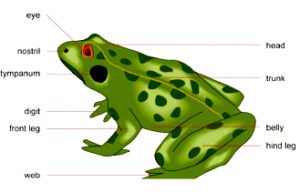General Characters:-
- The skin is smooth and slippery due to the presence of mucus.
- The skin is always maintained in a moist condition.
- The colour of dorsal side of body is generally olive green with dark irregular spots. On the ventral side the skin is uniformly pale yellow.
- The frog never drinks water but absorb it through the skin.
- Body of a frog is divisible into head and trunk A neck and tail are absent.
- Above the mouth, a pair of nostrils is present.

- Eyes are bulged and covered by a nictitating membrane that protects them while in water.
- On either side of the eyes, a membranous tympanum (ear) receives sound signals.
- The forelimbs and hind limbs help in swimming, walking, leaping and burrowing.
- The hind limbs end in five digits and they are larger and muscular than fore limbs that end in four digits.
- Feet have webbed digits that help in swimming.
- Frogs exhibit sexual dimorphism (male and female individuals of the same species are differentiated externally).
- Male frogs can be distinguished by the presence of sound producing vocal sacs and also a copulatory pad on the first digit of the fore limbs which are absent in female frogs.